

George Washington Carver
National Monument
Diamond, Missouri
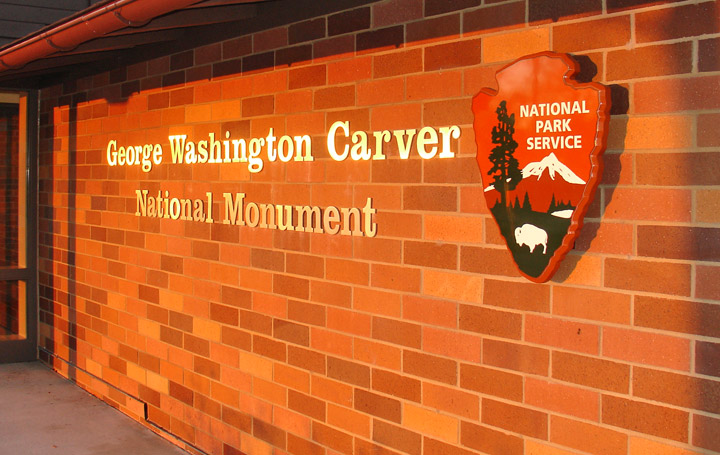
George Washington Carver (July 12,
1864 January 5, 1943) was an American botany researcher and agronomy educator
who worked in agricultural extension at the Tuskegee Institute, in Tuskegee,
Alabama, teaching former slaves farming techniques for self-sufficiency.
To bring education to farmers, Carver designed a mobile school, called a Jesup
Wagon after the New York financier, Morris Ketchum Jesup, who provided funding.
In 1921, Carver spoke in favor of a peanut tariff before the Ways and Means
Committee of the United States House of Representatives. Given racial
discrimination of the time, it was unusual for a black person to be called as an
expert. Carver's well received testimony earned him national attention, and he
became an unofficial spokesman for the peanut industry. Carver wrote 44
practical agricultural bulletins for farmers.
In the Reconstruction South, an agricultural monoculture of cotton depleted the
soil; and, in the early 20th century, the boll weevil destroyed much of the
cotton crop. Much of Carver's fame was based on his research and promotion of
alternative crops to cotton, such as peanuts and sweet potatoes. He wanted poor
farmers to grow alternative crops as both a source of their own food and a cash
crop. His most popular bulletin contained 105 existing food recipes that used
peanuts. His most famous method of promoting the peanut involved his creation of
about 100 existing industrial products from peanuts, including cosmetics, dyes,
paints, plastics, gasoline, and nitroglycerin. His industrial products from
peanuts excited the public imagination, but none was a successful commercial
product. There are many myths about Carver, especially the myth that his
industrial products from peanuts played a major role in revolutionizing Southern
agriculture.
Carver's most important accomplishments were in areas other than industrial
products from peanuts, including agricultural extension education, improvement
of racial relations, mentoring children, poetry, painting, religion, and
advocacy of sustainable agriculture and appreciation of plants and nature. He
served as a valuable role model for black Americans and others, and as an
example of the importance of hard work, a positive attitude, and a good
education. His humility, humanitarianism, good nature, frugality, and lack of
economic materialism also have been admired widely.
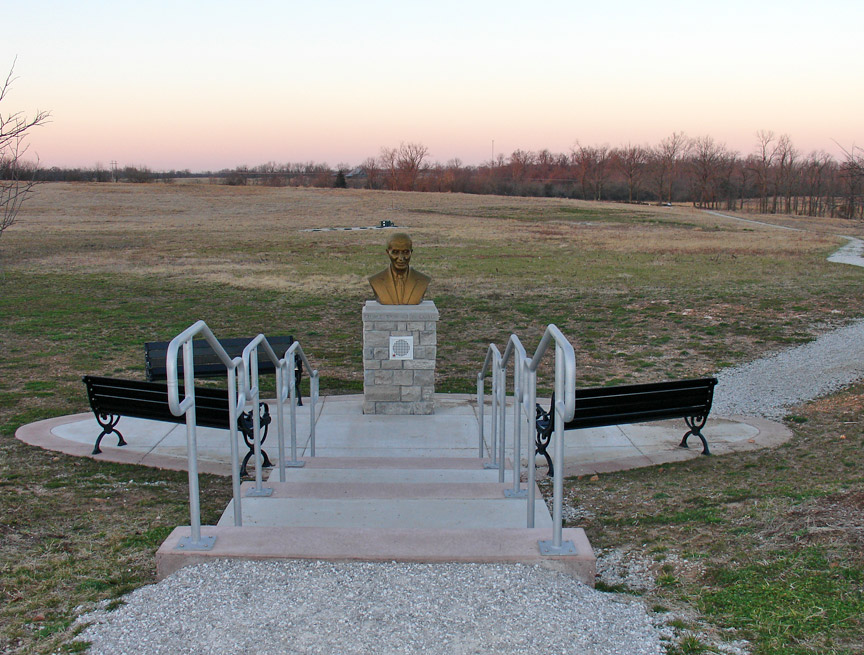
the National Monument near Diamond, Missouri where George Washington Carver was born into slavery
One of his most important roles was
in undermining, through the fame of his achievements and many talents, the
widespread stereotype of the time that the black race was intellectually
inferior to the white race. In 1941, Time magazine dubbed him a "Black
Leonardo", a reference to the white polymath Leonardo da Vinci.
He was born into slavery in Newton County, Marion Township, near Diamond Grove,
now known as Diamond, Missouri. He was born on July 12, 1864. His owner, Moses
Carver, was a German American immigrant who had purchased George's mother, Mary,
from William P. McGinnis on October 9, 1855 for seven hundred dollars. The
identity of Carver's father is unknown but he had sisters and a brother, all of
whom died prematurely.
When George was an infant, he, a sister, and his mother were kidnapped by night
raiders and sold in Arkansas, a common practice. Moses Carver hired John Bentley
to find them. Only Carver was found, orphaned and near death from whooping
cough. Carver's mother and sister had already died, although some reports stated
that his mother and sister had gone north with the soldiers. For returning
George, Moses Carver rewarded Bentley with his best filly that would later
produce winning race horses. This episode caused George a bout of respiratory
disease that left him with a permanently weakened constitution. Because of this,
he was unable to work as a hand and spent his time wandering the fields, drawn
to the varieties of wild plants. He became so knowledgeable that he was known by
Moses Carver's neighbors as the "Plant Doctor."
One day he was called to a neighbor's house to help with a plant in need. When
he had fixed the problem, he was told to go into the kitchen to collect his
reward. When he entered the kitchen, he saw no one. He did, however, see
something that changed his life: beautiful paintings of flowers on the walls of
the room. From that moment on, he knew that he was going to be an artist as well
as a botanist.
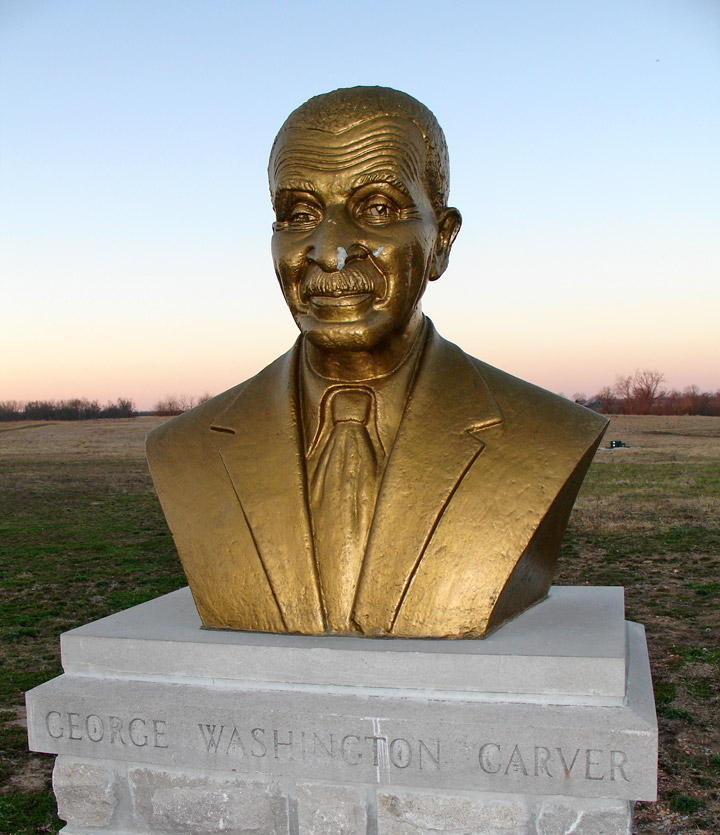
After slavery was abolished, Moses Carver and his wife Susan raised George and
his brother Jim as their own children. They encouraged George Carver to continue
his intellectual pursuits and "Aunt Susan" taught him the basics of reading and
writing.
Since blacks were not allowed at the school in Diamond Grove and he had received
news that there was a school for blacks ten miles (16 km) south in Neosho, he
resolved to go there at once. To his dismay, when he reached the town, the
school had been closed for the night. As he had nowhere to stay, he slept in a
nearby barn. By his own account, the next morning he met a kind woman, Mariah
Watkins, from whom he wished to rent a room. When he identified himself
"Carver's George," as he had done his whole life, she replied that from now on,
his name was "George Carver." George liked this lady very much and her words
"You must learn all you can, then go back out into the world and give your
learning back to the people," made a great impression on him.
At the age of thirteen, due to his desire to attend high school, he relocated to
the home of another foster family in Fort Scott, Kansas. After witnessing the
beating to death of a black man at the hands of a group of white men, George
left Fort Scott. He subsequently attended a series of schools before earning his
diploma at Minneapolis High School in Minneapolis, Kansas.
After high school, George started a laundry business in Olathe, Kansas.
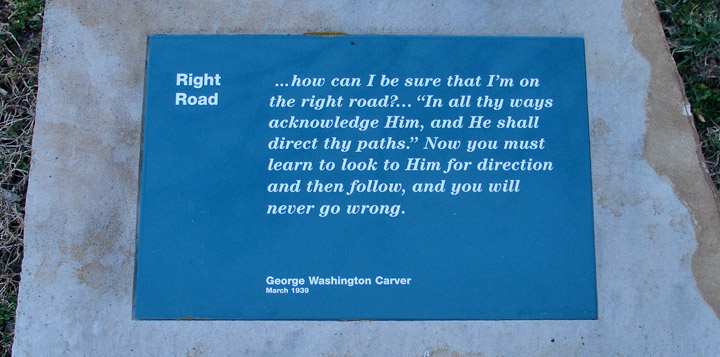
Over the next five years, he sent several letters to colleges and was finally
accepted at Highland College in Highland, Kansas. He traveled to the college,
but he was rejected when they discovered that he was an African American.
Carver's travels took him to Winterset, Iowa in the mid-1880s, where he met the
Milhollands, a white couple whom he later credited with encouraging him to
pursue higher education. The Milhollands urged Carver to enroll in nearby
Simpson College in Indianola, Iowa, which he did despite his reluctance due to
his previous rejection at Highland College.
In 1887, he was accepted into Simpson as its second African-American student.
While in college at Simpson, he showed a strong aptitude for singing and art.
His art teacher, Etta Budd, was the daughter of the head of the department of
horticulture at Iowa State: Joseph Budd. Etta convinced Carver to pursue a
career that paid better than art and so he transferred to Iowa State. The
encouragement Etta Budd gave Carver to seek a better-paying career was
well-warranted, at least for Etta. She died a poor retired art teacher in a
Boone, Iowa retirement home.
He transferred in 1891 to Iowa State Agricultural College, where he was the
first black student, and later the first black faculty member. In order to avoid
confusion with another George Carver in his classes, he began to use the name
George Washington Carver.

At the end of his undergraduate career in 1894, recognizing Carver's potential,
Joseph Budd and Louis Pammel convinced Carver to stay at Iowa State for his
master's degree. Carver then performed research at the Iowa Agriculture and Home
Economics Experiment Station under Pammel from 1894 to his graduation in 1896.
It is his work at the experiment station in plant pathology and mycology that
first gained him national recognition and respect as a botanist.
In 1896, Carver was invited to lead the Agriculture Department at the five year
old Tuskegee Normal and Industrial Institute, later Tuskegee University, by its
founder, Booker T. Washington, in Tuskegee, Alabama. Carver accepted the
position, and remained there for 47 years, until his death in 1943. Carver never
married.
Carver had numerous problems at Tuskegee before he became famous. Carver's
perceived arrogance, his higher than normal salary and the two rooms he received
for his personal use were resented by other faculty. Single faculty members
normally bunked two to a room. One of Carver's duties was to administer the
Agricultural Experiment Station farms. He was expected to produce and sell farm
products to make a profit. He soon proved to be a poor administrator. In 1900,
Carver complained that the physical work and the letter-writing his agricultural
work required were both too much for him.
In 1902, Booker T. Washington invited a nationally famous woman photographer to
Tuskegee. Carver and Nelson Henry, a Tuskegee graduate, accompanied the
attractive white woman in the town of Ramer. Several white citizens thought
Henry was improperly associating with a white woman. Someone fired three pistol
shots at Henry and he fled. Mobs prevented him from returning. Carver considered
himself fortunate to escape alive.
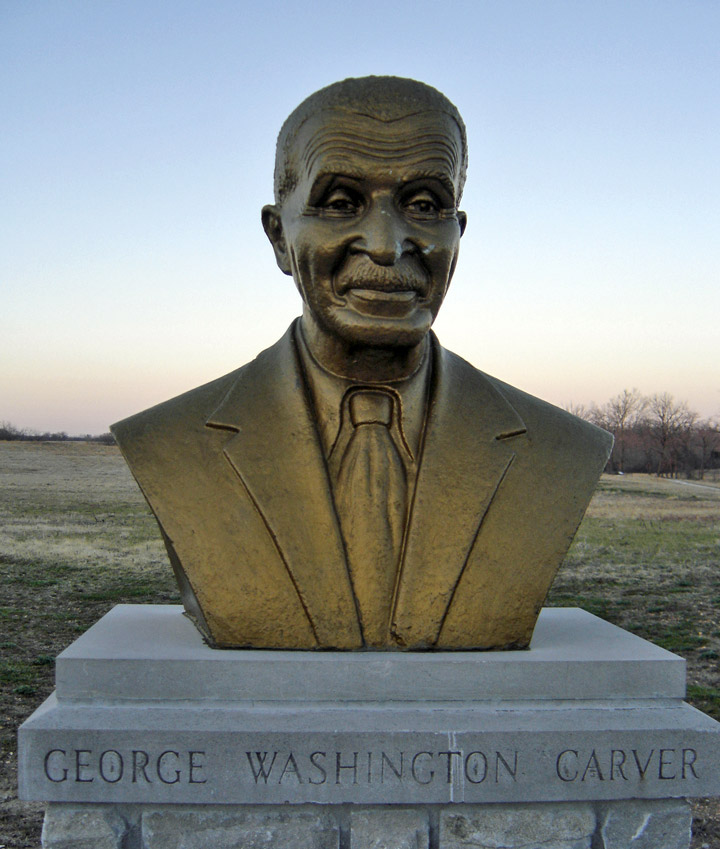
In 1904, a committee reported that Carver's reports on the poultry yard were
exaggerated, and Washington criticized Carver about the exaggerations. Carver
replied to Washington "Now to be branded as a liar and party to such hellish
deception it is more than I can bear, and if your committee feel that I have
willfully lied or [was] party to such lies as were told my resignation is at
your disposal." In 1910, Carver submitted a letter of resignation in response to
a reorganization of the agriculture programs. Carver again threatened to resign
in 1912 over his teaching assignment. Carver submitted a letter of resignation
in 1913, with the intention of heading up an experiment station elsewhere. He
also threatened to resign in 1913 and 1914 when he didn't get a summer teaching
assignment. In each case, Washington smoothed things over. It seemed that
Carver's wounded pride prompted most of the resignation threats, especially the
last two because he did not need the money from summer work.
In 1911, Washington wrote a lengthy letter to Carver complaining that Carver did
not follow orders to plant certain crops at the experiment station. He also
refused Carver's demands for a new laboratory and research supplies for Carver's
exclusive use and for Carver to teach no classes. He complimented Carver's
abilities in teaching and original research but bluntly stated his poor
administrative skills, "When it comes to the organization of classes, the
ability required to secure a properly organized and large school or section of a
school, you are wanting in ability. When it comes to the matter of practical
farm managing which will secure definite, practical, financial results, you are
wanting again in ability." Also in 1911, Carver complained that his laboratory
was still without the equipment promised 11 months earlier. At the same time,
Carver complained of committees criticizing him and that his "nerves will not
stand" any more committee meetings.
Despite their clashes, Booker T. Washington praised Carver in the 1911 book, My
Larger Education: Being Chapters from My Experience. Booker called Carver "one
of the most thoroughly scientific men of the Negro race with whom I am
acquainted." Like most later Carver biographies, it also contained
exaggerations. It inaccurately claimed that as a young boy Carver "proved to be
such a weak and sickly little creature that no attempt was made to put him to
work and he was allowed to grow up among chickens and other animals around the
servants' quarters, getting his living as best he could." Carver wrote elsewhere
that his adoptive parents, the Carvers, were "very kind" to him.
Booker T. Washington died in 1915. His successor made fewer demands on Carver.
From 1915 to 1923, Carver's major focus was compiling existing uses and
proposing new uses for peanuts, sweet potatoes, pecans and other crops. This
work and especially his promotion of peanuts for the peanut growers association
and before Congress eventually made him the most famous African-American of his
time.
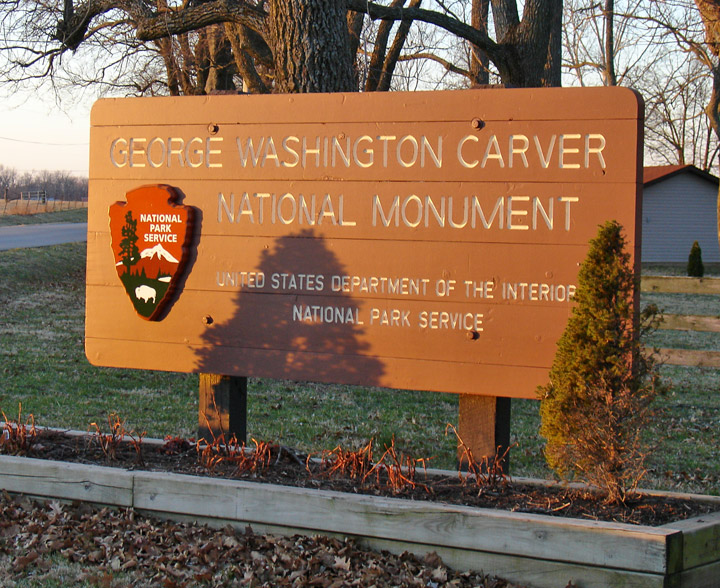
Carver had an interest in helping poor Southern farmers who were working low
quality soils that had been depleted of nutrients by repeated plantings of
cotton crops. He and other agricultural workers urged farmers to restore
nitrogen to their soils by practicing systematic crop rotation, alternating
cotton crops with plantings of sweet potatoes or legumes (such as peanuts,
soybeans and cowpeas) that were also sources of protein. Following the crop
rotation practice resulted in improved cotton yields and gave farmers new foods
and alternative cash crops. In order to train farmers to successfully rotate
crops and cultivate the new foods, Carver developed an agricultural extension
program for Alabama that was similar to the one at Iowa State. In addition, he
founded an industrial research laboratory where he and assistants worked to
popularize use of the new plants by developing hundreds of applications for them
through original research and also by promoting recipes and applications that
they collected from others. Carver distributed his information as agricultural
bulletins.
Much of Carver's fame is related to the hundreds of plant products he supposedly
invented. However, the number and impact of Carver's inventions have been
greatly inflated. After Carver's death, lists were created of the plant products
Carver compiled or originated. Such lists enumerate about 300 applications for
peanuts and 118 for sweet potatoes, although 73 of the 118 were dyes. He made
similar investigations into uses for cowpeas, soybeans and pecans. Carver did
not write down formulas for most of his novel plant products so they could not
be made by others. None of Carver's peanut products was ever a commercial
success so they did not revolutionize Southern agriculture as frequently
claimed. Carver is also often incorrectly credited with the invention of peanut
butter.
Until 1921, Carver was not widely known for his agricultural research. However,
he was known in Washington, D.C. President Theodore Roosevelt publicly admired
his work. James Wilson, a former Iowa state dean and teacher of Carver's, was
U.S. Secretary of Agriculture from 1897 to 1913. Henry Cantwell Wallace, U.S.
Secretary of Agriculture from 1921 to 1924, was one of Carver's teachers at Iowa
State. Carver was a friend of Wallace's son, Henry A. Wallace, also an Iowa
State graduate. The younger Wallace served as U.S. Secretary of
Agriculture from 1933 to 1940 and as Franklin Delano Roosevelt's Vice President
from 1941-1945.
In 1916 Carver was made a member of the Royal Society of Arts in England, one of
only a handful of Americans at that time to receive this honor. However,
Carver's promotion of peanuts gained him the most fame.
In 1919, Carver wrote to a peanut company about the great potential he saw for
his new peanut milk. Both he and the peanut industry seemed unaware that in
1917, William Melhuish had secured patent #1,243,855 for a milk substitute made
from peanuts and soybeans. Despite reservations about his race, the peanut
industry invited him as a speaker to their 1920 convention. He discussed "The
Possibilities of the Peanut," and exhibited 145 peanut products.
By 1920, U.S. peanut farmers were being undercut with imported peanuts from the
Republic of China. White peanut farmers and processors came together in 1921 to
plead their cause before a Congressional committee hearings on a tariff. Carver
was elected to speak at the hearings because he had spoken at the convention of
the United Peanut Associations of America. Carver was a novel choice because of
U.S. racial segregation. On arrival, Carver was mocked by surprised Southern
congressmen, but he was not deterred and began to explain some of the many uses
for the peanut. Initially given ten minutes to present, the now spellbound
committee extended his time again and again. The committee rose in applause as
he finished his presentation, and the Fordney-McCumber Tariff of 1922 included a
tariff on imported peanuts. Carver's presentation to Congress made him famous,
while his intelligence, ability to communicate, and amiability and courtesy
delighted the general public.
During the last two decades of his life, Carver seemed to enjoy his celebrity
status. He was often traveling to promote Tuskegee, peanuts or racial harmony.
Although he only published six agricultural bulletins after 1922, he published
articles in peanut industry journals and wrote a syndicated newspaper column,
"Professor Carver's Advice." Business leaders came to seek his help, and he
often responded with free advice. Three American presidents Theodore
Roosevelt, Calvin Coolidge and Franklin Roosevelt met with him, and the Crown
Prince of Sweden studied with him for three weeks.
In 1923, Carver received the Spingarn Medal from the NAACP, awarded annually for
outstanding achievement. From 1923 to 1933, Carver toured white Southern
colleges for the Commission on Interracial Cooperation.
Carver was famously criticized in a
Nov. 20, 1924 New York Times article "Men of Science Never Talk That Way." The
Times considered Carver's statements that God guided his research were
inconsistent with a scientific approach. The criticism garnered a lot of
sympathy for Carver because Christians viewed it as an attack on religion.
In 1928, Simpson College bestowed Carver with an honorary doctorate. For a 1929
book on Carver, Raleigh H. Merritt contacted Carver. Merritt wrote "At present
not a great deal has been done to utilize Dr. Carver's discoveries commercially.
He says that he is merely scratching the surface of scientific investigations of
the possibilities of the peanut and other Southern products." [23] Yet in 1932,
Professor of Literature, James Saxon Childers wrote that Carver and his peanut
products were almost solely responsible for the rise in U.S. peanut production
after the boll weevil devastated the American cotton crop beginning about 1892.
Childer's 1932 article on Carver, "A Boy Who Was Traded for a Horse" in The
American Magazine and its 1937 reprint in Reader's Digest did much to establish
this Carver myth. Other major magazines and newspapers of the time also
exaggerated Carver's impact on the peanut industry.
From 1933 to 1935, Carver was largely occupied with work on peanut oil massages
for treating infantile paralysis (polio). Carver received tremendous media
attention and visitations from parents and their sick children; however, it was
ultimately found that peanut oil was not the miracle cure it was made out to
be--it was the massages which provided the benefits. Carver had been a trainer
for the Iowa State football team and was skilled as a masseur. From 1935 to
1937, Carver participated in the USDA Disease Survey. Carver had specialized in
plant diseases and mycology for his Master's degree.
In 1937, Carver attended two chemurgy conferences. He met Henry Ford at
the Dearborn, MI conference, and they became close friends. Also, in 1937,
Carver's health declined. Time magazine reported in 1941 that Henry Ford
installed an elevator for Carver because his doctor told him not to climb the 19
stairs to his room. In 1942, the two men denied that they were working
together on a solution to the wartime rubber shortage. Carver also did work with
soy, which he and Ford considered as an alternative fuel.
In 1939, Carver received the Roosevelt Medal for Outstanding Contribution to
Southern Agriculture inscribed "to a scientist humbly seeking the guidance of
God and a liberator to men of the white race as well as the black." In 1940,
Carver established the George Washington Carver Foundation at the Tuskegee
Institute. In 1941, the George Washington Carver Museum was dedicated at the
Tuskegee Institute. In 1942, Henry Ford built a replica of Carver's slave cabin
at the Henry Ford Museum and Greenfield Village in Dearborn, MI as a tribute to
his friend. Also in 1942, Ford dedicated the George Washington Carver Laboratory
in Dearborn, Michigan.
Upon returning from home one day, Carver took a bad fall down a flight of
stairs; he was found unconscious by a maid who took him to a hospital. Carver
died January 5, 1943 at the age of 78 from complications (anemia) resulting from
this fall. He was buried next to Booker T. Washington at Tuskegee University.
On his grave was written the simplest and most meaningful summary of his life.
He could have added fortune to fame, but caring for neither, he found happiness
and honor in being helpful to the world.
Before and after his death, there was a movement to establish a U.S. national
monument to Carver. However, because of World War II such non-war expenditures
were banned by presidential order. Missouri Senator Harry S Truman sponsored a
bill anyway. In a committee hearing on the bill, one supporter argued that "The
bill is not simply a momentary pause on the part of busy men engaged in the
conduct of the war, to do honor to one of the truly great Americans of this
country, but it is in essence a blow against the Axis, it is in essence a war
measure in the sense that it will further unleash and release the energies of
roughly 15,000,000 Negro people in this country for full support of our war
effort." The bill passed in both houses without a single vote against.
On July 14, 1943, President Franklin Delano Roosevelt dedicated $30,000 for the
George Washington Carver National Monument west-southwest of Diamond, Missouri -
an area where Carver had spent time in his childhood. This was the first
national monument dedicated to an African-American and first to a non-President.
At this 210-acre (0.8 km²) national monument, there is a bust of Carver, a
¾-mile nature trail, a museum, the 1881 Moses Carver house, and the Carver
cemetery. Due to a variety of delays, the National Monument was not opened until
July, 1953.
In December 1947, a fire destroyed all but three of 48 of Carver's paintings at
the Carver Museum Carver appeared on U.S. commemorative stamps in 1948 and 1998,
and was depicted on a commemorative half dollar coin from 1951 to 1954. The USS
George Washington Carver (SSBN-656) is also named in his honor.
In 1977, Carver was elected to the Hall of Fame for Great Americans. In 1990,
Carver was inducted into the National Inventors Hall of Fame. In 1994, Iowa
State University awarded Carver the Doctor of Humane Letters. In 2000, Carver
was a charter inductee in the USDA Hall of Heroes as the "Father of Chemurgy."
In 2005, Carver's research at the Tuskegee Institute was designated a National
Historic Chemical Landmark by the American Chemical Society. On February
15, 2005, an episode of Modern Marvels included scenes from within Iowa State
University's Food Sciences Building and about Carver's work. In 2005, the
Missouri Botanical Garden in St. Louis, Missouri opened a George Washington
Carver garden in his honor, which includes a life size statue of him.
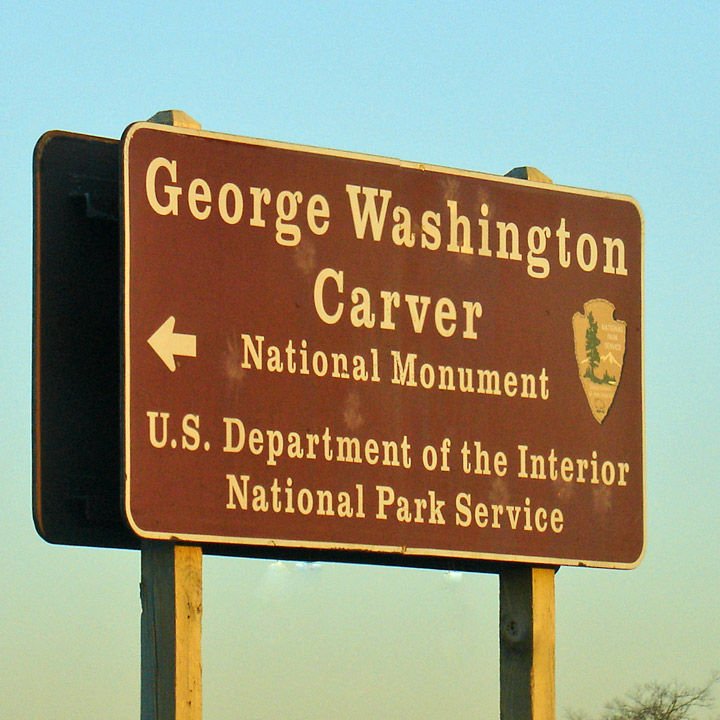
Many institutions honor George Washington Carver to this day, particularly the
American public school system. Dozens of elementary schools and high schools are
named after him. Ironically, despite his fame and wish to share his work with
all mankind, few of Carver's writings are available online, just 3 of 44
bulletins, a poem or two and a few dozen inspirational quotations.
Text from Wikipedia